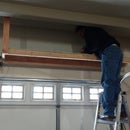Introduction: Harvesting and Canning Honey: the Crush and Strain Method
Sometimes your bees do well all year round producing honey and keeping their hive clean and tidy and then the worst winter in many years happens and they all die with a lot of honey in the hive because it gets cold and stays cold for several weeks without any warmup at all. Sometimes.
This allowed me to do something you would normally never do; harvest all of the honey from the hive. Usually you want to harvest only a little of the honey so that the bees always have a healthy supply to make it through hungry and cold times.
What you will want to have:
Honeycomb
Large Bowl
Sturdy Wooden Spoon or other Smooshing Implement
Sanitized Canning Jars and Lids (a run through a hot modern dishwasher should be good for this application)
Jelly Straining Bag and Stand
Step 1: Be Good to Your Bees
Even when you give them good care, proximity and access to good water and tons of pesticide-free flowers, your bee hive can fail in the middle of the winter.
I have a great Kenyan style top-bar hive that a friend who keeps over a dozen hives made for me (his fared no better this winter, he lost 60% of his hives to the cold as well) and even with thick cedar walls and an excellent roof, the bees had a tough time.
Step 2: Remove Comb From the Frames
After you have had a pleasantly somber eulogy for your bees, it is time to clean out the hive of anything that could attract pests or mold. So sweep out the dead insects, clear out the frames filled with wax and pollen and (now dead) brood. The honey harvest from a top-bar hive is quite easy, but unfortunately means the wax will probably be crushed in the process (there are ways to keep this from happening, but I needed to clean it out to keep away wax moths anyway).
Step 3: Smoosh It Up
Once the full honeycomb has been sliced away from the top bar, or frame, into a bowl- you get to smoosh it up!
You can start breaking the chunks of comb up with your hands or use a large wooden spoon, meat tenderizing hammer or potato masher. Quite simple, but sticky process at this point.
Step 4: Filtering the Honey
Setting up your jelly filter stand over a large shallow bowl or plate (to catch any drips) and place your first jar with a wide-mouth funnel underneath.
Scoop as much broken comb into your jelly filter bag in the stand as you can safely fit without making even more of a sticky mess (don't worry, there will be stickyness in any honey processing, it happens).
Wait.
Wait some more.
Put it in the sun to maybe heat up the honey so it drips through faster...
Wait.
Remember to look at the jar!
Oh, it's full!
Switch it out with another jar quick!
Step 5: Put a Lid on It
Canning honey is the easiest canning you will ever do.
Honey is an amazing food in that it is dry enough (has a low water content) and sweet enough (has so much natural sugar) that most molds and bacteria that are harmful to humans or cause spoilage cannot survive in it. This means that if you have a sanitized jar and lid, you are totally good to pour honey into it and cap it off.
There are, however, things present in raw honey that make it very dangerous for babies, do not feed honey to children under the age of 1. Once a child has reached 12 months old, their stomach lining is sturdy enough to pass these potentially harmful presences out without any problem.
Put the clean and dry seal top and screw lid onto the jar, label it and put it somewhere cool and dark.
Raw (unheated) honey like this will likely crystallize at some point, this does nothing to the delicious taste, only the texture. If you want, you can heat the sealed jar in a bowl full of warm water to liquefy the honey again if this occurs.
Enjoy!

Runner Up in the
Canning and Pickling Challenge 2017













